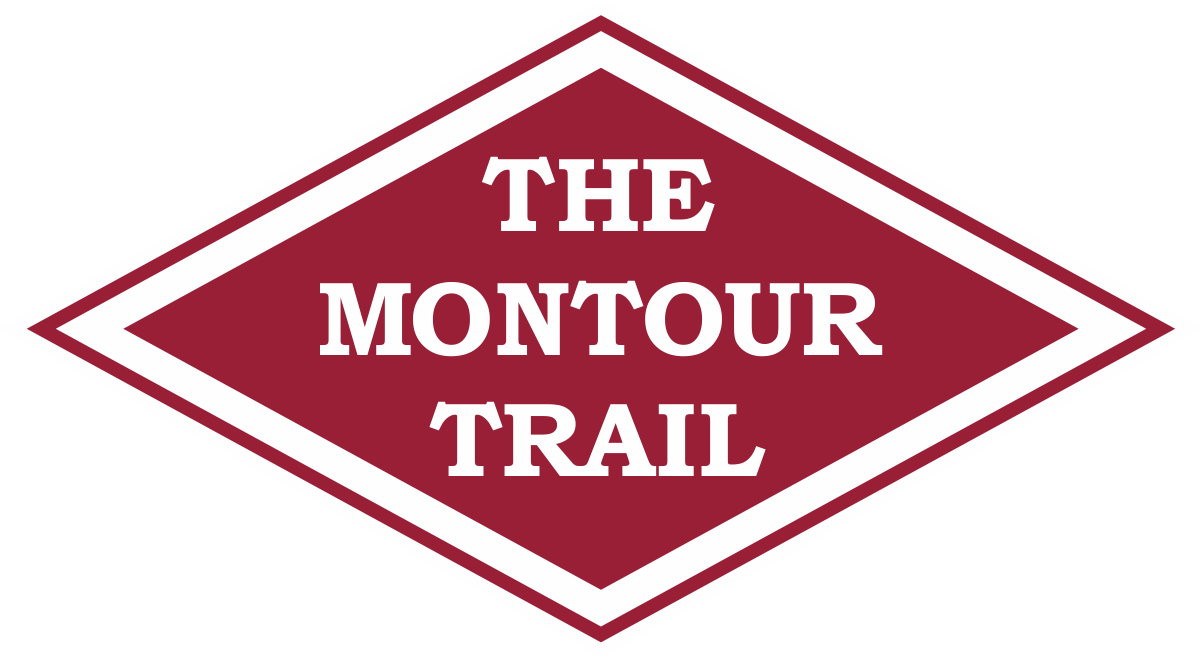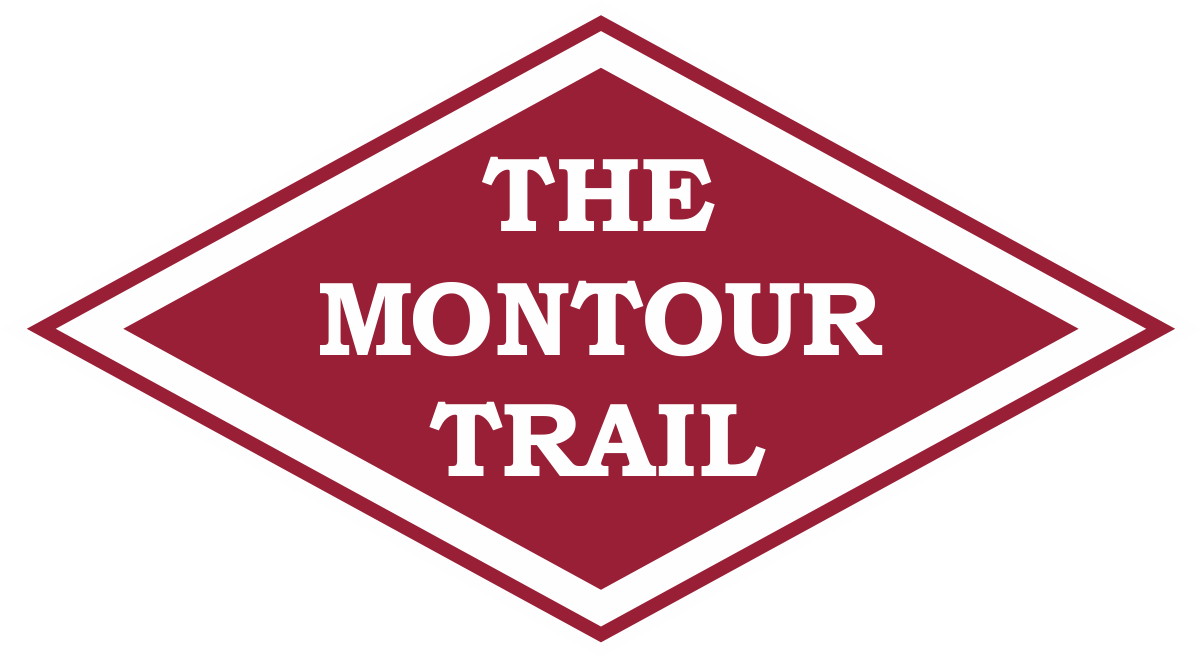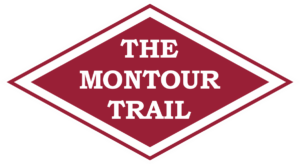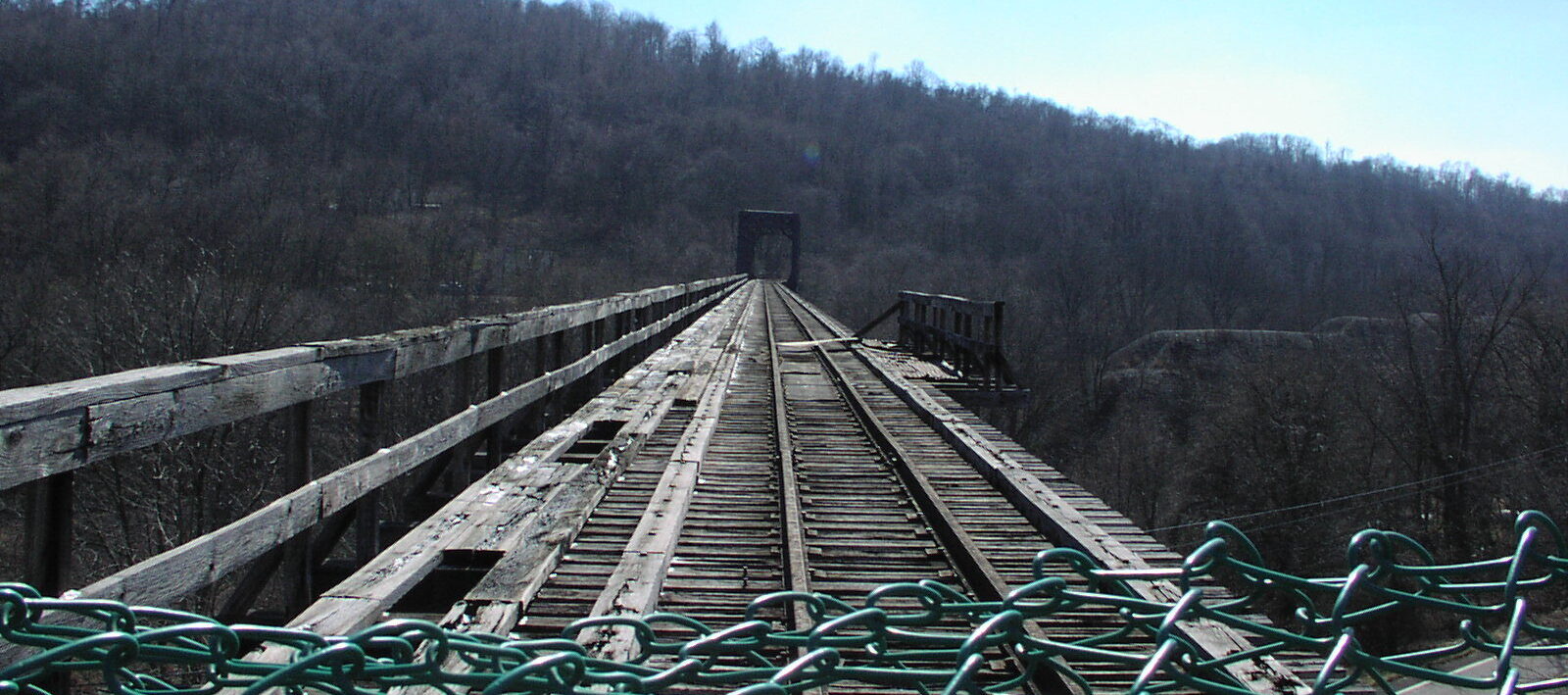Founding Fathers
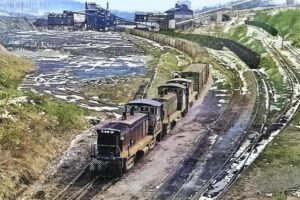 The Montour Trail began life as the coal-carrying Montour Railroad, in 1877, feeding the area’s steel mills. At its peak, the railroad carried 7 million tons of coal per year. Around the turn of the 20th century, it added passenger service (1902 to 1927). American heavy industry sagged after World War II, and the Montour Railroad declined to its final end, in 1984, when the steel rails and any railroad ties worth salvaging were removed.
The Montour Trail began life as the coal-carrying Montour Railroad, in 1877, feeding the area’s steel mills. At its peak, the railroad carried 7 million tons of coal per year. Around the turn of the 20th century, it added passenger service (1902 to 1927). American heavy industry sagged after World War II, and the Montour Railroad declined to its final end, in 1984, when the steel rails and any railroad ties worth salvaging were removed.
Three Years from Start to Finish
Later that same year, the Trail rose from disuse when Peters Township bought six miles of the railbed — creating a hiking/biking trail called Arrowhead. Two avid cyclists took it from there: Stan Sattinger and Dino Angelici responded enthusiastically to a request from the Pittsburgh Council of the American Youth Hostels to see what could be done with the “bones” of the old Montour RR, at that point a rough linear wasteland of unleveled ballast. The founding of the Montour Trail Council in 1989 was the result.
Sattinger was a Westinghouse engineer who liked biking and trains; Angelici was a dentist who was interested in developing a rails-to-trails project in the Pittsburgh area, just as the concept was gaining interest nationally. After many hours of discussion, they “took the bull by the horns,” held an organizational meeting, and jumped on for what would be an unexpectedly long ride. Two dozen people attended the first meeting, many of them eventual founding board members. The organization decided to focus solely on the
Montour, even though other abandoned rail lines (such as along the Youghiogheny River) were also of interest.
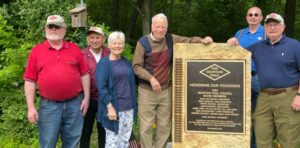
Some of the original MTC founders celebrating the installation of the plaque honoring them: (L to R): Dennis Sims, Dave Wright, Lee Wilson (Dick’s widow), Peter Kohnke, Tim Killmeyer, Jason Ortitay (State Representative, 46th district)
Trail originals consistently chuckle about the Montour Trail’s initial concept plan, which envisioned completing the job in three years. Sattinger pointed out, “If we had said back then that it would take 25 years, it might have dampened some enthusiasm. The fact that it came to fruition in increments was a constant reminder to others to get with the program.”
Recruiting Talent
Jack Swisher was already using the trail right-of-way before the Montour Trail Council was born, tackling the bumpy ballast surface alongside the abandoned rail line on a mountain bike. His incorporation into MTC is a textbook example of how fledgling organizations recruit talent. An accountant by trade, he was a member of the Rails-to-Trails Conservancy; that organization supplied its local mailing list to Sattinger and Angelici when they were looking for supporters. “I thought the Trail idea sounded interesting, but didn’t stand a snowball’s chance in hell of coming to fruition,” Swisher said when he realized that the group was private citizens — not government funders nor corporate executives who could write big checks. He became the Council’s first treasurer, mastering IRS regulations for tax-exempt entities to save MTC thousands of dollars, then served a stint as president. Wanting to do more, he trained to become a welder so he could construct gates and bridge railings along the Trail.
Putting Sales Connections to Work
Paul Mitsdarfer — an avid runner, cyclist, cross-country skier, and railroad memorabilia collector — used the unimproved, abandoned railroad line near his home in Peters as a workout facility. His wife, Dottie, often accompanied him and remembers having to watch out for kids zooming along recklessly on motorbikes. Career-wise, Mitsdarfer was a salesman with a large number of corporate contacts; a family connection introduced him to the Trail’s founding group, and the rest is history. Mitsdarfer joined the board for a term, then used his sales connections to recruit sponsors during MTC’s early years. He also participated in work parties during construction of the Moon–Robinson section in the 1990s.
Growing Membership
George Schmidt, millwright, served as president for the Western Pennsylvania Wheelmen in the late 1980s. An original MTC board member as well, he was the centerpiece of the strategic alliance between these two organizations, a major player in expanding bicycling opportunities around Pittsburgh. He organized public political advocacy after mishaps between bikers and walkers in North Park led to a proposal to eliminate the area’s bike lane. The Wheelmen fought off that threat and cosponsored the study that identified western Pennsylvania railroad rights of way, including the Montour, that were available for conversion to recreational trails. “Although WPW was a road riding organization, the concept of bicycle trails separate from highways was very attractive,” Schmidt recalled. “By promoting rails-to-trails, we nearly tripled our membership, from 800 to over 2,000.” The Wheelmen used some of their increased revenues to give startup grants to fledgling rails-to-trails organizations like the Montour.
A Deal You Can’t Refuse
Larry Ridenour recalls, “When I was a child, I had a Donald Duck comic book with a story about using an old railroad bed as a hiking trail. So this was always in the back of my mind.” As an urban planner many years later, he became a crucial contributor to Pittsburgh/ Allegheny County’s recreational trail network. His skill at negotiating land acquisition greatly contributed to MTC’s effort to build the Trail’s MM 0.0 to MM 7.3: He made a “deal you can’t refuse” with Duquesne Light, which was installing power lines alongside the railroad to support construction of the new Pittsburgh airport. “Give me two years and I will get the money to buy your right of way,” Ridenour proposed, then set to work raising funds with MTC. A hike on the Appalachian Trail was the inspiration for combining government land ownership with volunteer maintenance by locals, leading to the Friends groups concept.
Running with a Camera
In the late 1980s, Jerry Agin stumbled upon the Montour Trail while searching for new and adventurous off-road routes for long-distance running. “I got topographic maps of where it went,” he said. “Each time I went out to explore, I discovered more trail, and then got another topo so I could go farther.” In time, he learned about the budding Trail council and attended a meeting. His first task was to take photos of the proposed route — a 25-plus-mile trek that was strewn with railroad ballast and miscellaneous debris, too difficult to navigate by bike. Agin offered to run on the Trail with a camera, taking pictures along the way. A computer scientist and musician, he was MTC’s first membership chairman, managing the database, member communications, and initial website as membership rose gradually from zero to over 700.
Build It and They Will Come
When cycling enthusiast Bill Metzger learned that the Rails-to-Trails Conservancy was conducting a study of abandoned western Pennsylvania railroads, he met with the consultant and immediately got excited, because he knew that the Montour Railroad cut straight through the hills “that I was riding and hating every inch of.” He joined his friend Stan Sattinger as an original board member and key promoter, developing the slide show that would be presented to dozens of local groups. Metzger also created the Montour Trail’s maps and brochures, helped to design the logo that appears on Trail mileposts, and built the first set of rule signs on his back porch. “When we were beginning the Trail, the movie Field of Dreams was popular. Well, we built it and they came. And 30 years later, they still are coming,” he adds.
Our Original Volunteers

Founders gathered during the 30th MTC anniversary celebration: From left to right: Front row, Bill Metzger and Paul McKeown; Back Row: Peter Kohnke, Tom Dougherty, Jerry Agin, Dennis Sims, Tim Killmeyer, Dennis Pfeiffer, Jerry and Stan Sattinger, and Ned Williams
Some of the original founders are still active as MTC volunteers. To honor them, the Montour Trail-Letter published articles about each of them. Download this document to read the full stories detailing the contributions each of them made.
Cutting Down the Hills
Throughout his professional career, railroad lawyer Dick Wilson handled matters related to interstate commerce, including abandonment of rail lines. In the Montour’s case, the challenge was to purchase the right of way from the railroad company and place it under the control of either county government or a nonprofit entity. “My primary motivation for getting involved,” he explained, “was that these rail lines would make great recreational trails, especially because many of them ran along scenic waterways, and it would be a waste of a valuable transportation resource to let these rights of way evaporate.” Wilson’s negotiation on behalf of MTC was nearly as serpentine as those scenic waterways; it meandered from the railroad company to the Pennsylvania Public Utility Commission to Commonwealth Court to PennDOT before it was settled. Wilson has continued to serve the Council throughout its history, participating in several hundred legal agreements.
Getting Municipal Buy-in
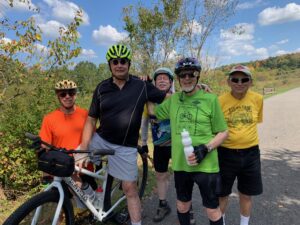
Some of the original Montour Trail Council founders met up in 2023 for a mid-autumn bike ride. L to R: Dino Angelici (first MTC VP), Tim Killmeyer, Paul McKeown, Stan Sattinger (first MTC president), Dave Wright.
An avid cyclist since childhood, Tim Killmeyer signed on with MTC prior to a development planning meeting with the Robinson Township parks board. “They asked us various questions and told us to find out the answers and then come back. We gave them the answers at the next meeting, but then they had more questions,” Killmeyer recalled. “We realized that if we had to go through the same process with 12 municipalities, the Trail might never get built. So we agreed that we had to start our own organization, obtain the right of way, and build the Trail ourselves.” Killmeyer’s founding role was to make presentations to local nonprofits, consequently obtaining endorsements that would occupy prominent places in early grant proposals and Trail brochures. He also has served MTC as project manager for Trail construction (Moon, Robinson and airport connector), newsletter coordinator, and Tour the Montour T-shirt designer.
Engineering the Corridor
Engineer Peter Kohnke was initially recruited for MTC from the Rails-to-Trails Conservancy donor base. He agreed to become the first secretary; he later served as board president. While other members focused on creating the main line, Kohnke was excited to see a section extending into Bethel Park. But when told that the branch was less important because it “didn’t go anywhere,” Kohnke shot back, “Yes, it does. It goes to my house!” He became the branch’s unofficial champion. Kohnke holds another special place in Montour Trail history: When property on Pleasant Street in South Park Township was subdivided for residential construction (right in the middle of the proposed Trail), he personally purchased one of the lots and held it until the Montour Trail Council had money to buy it from him. It’s called the Kohnke Corridor.
Location, Location, Location
Dave Wright has almost certainly given more time to the Montour Trail than any other human being. Some of his enormous productivity has been on paid time, through his work as an Allegheny County Department of Public Works civil engineer. He has also volunteered thousands of hours as MTC’s property acquisition expert, reviewing deeds to determine what properties the railroad owned and acquire title for easements. With a motto of “be persistent and respectful,” Wright seeks out innovative solutions — such as the Triphammer to Piney Fork section, a result of a mutually beneficial land swap with neighboring businessman, and recycling old bridges. Though Wright served only one term on the board (to avoid conflict of interest with his employer), he had a hand in virtually every Montour Trail project in Allegheny County.
The First Miles in Cecil
Dennis Sims has been the MTC’s driving force in Cecil, where the first four miles of MTC-constructed trail opened. But then, and now, he took a lot of blame for rainy days on the trail, since he is a career meteorologist. The founders didn’t need their own weather connections — they needed the media connections that a weather professional could deliver. Sims, a biker and a railroad fan, jumped in with both feet to become MTC’s first newsletter editor and public-relations front man. He recruited his colleagues to support the project with valuable television coverage of noteworthy trail development milestones and promotional videos. He expanded his media influence by building relationships with local newspaper reporters. And when he discovered a website on Montour Railroad history, Simms thought, “These guys need the Trail — and we could use their insight to put up historical markers.” Thus was born the 7th Friends group, the Montour Railroad Historical Society.
One Mile at a Time
Corporate marketer and outdoor enthusiast Tom Dougherty was a local Sierra Club member when the chapter president asked him to check out another guy’s idea: to transform an abandoned railroad into something more valuable. That guy was Stan Sattinger. Coincidentally, the Dougherty family was moving into a new house five doors down the street from Stan’s! Early board meetings focused on huge problems that seemed like deal-breakers. But the people who rubbed elbows on the board always found a workable solution through divide and conquer. Dougherty ‘s main contribution was creating presentations and submitting proposals to foundations/corporations to secure funding. Constructing low-mileage segments where possible became the best way to generate widespread support in different communities — as well as show constant progress, because it would inspire the volunteers to keep working to get the next connecting section done.
Read the details of MTC’s year-by year accomplishments by clicking MTC Milestones.
